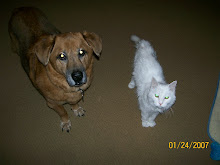The poisoning of pet food meat begins with the hormones fed to livestock to make them grow faster, so they can be slaughtered that much sooner. Pets who eat hormone-injected, ground-up and processed meat by-products every day are definitely at greater risks.
The daily feed of livestock is also laced with "maintenance doses" of antibiotics intended to prevent disease. As likely, these drugs instill toxicity that increases cancer risks, both in the livestock and the pets that feed on processed meat. And again, a pet fed the same diet of antibiotic-laced substandard meat every day is at far greater risk of cancer than a person eating choice cuts on an occasional basis.
These guidelines (from the AAFCO), such as they are, ignore a whole other category of livestock: the direly sick animals who collapse from one disease or another and, as a result, never reach the slaughterhouse. These animals are deemed unfit for human consumption, killed, and sent off to "rendering" (the boiling of any animal substance discarded by slaughterhouses as unfit for human consumption) plants which supply meat protein used in livestock and pet feed. This is an established, if little-publicized industry and that "rendered" animal substances go directly into livestock and pet feed. These substances may include "4-D" meat: meat from dead animals, dying animals, and diseased and disabled animals. These 4-D carcasses may have cancerous tumors, worm-infested organs, and the like--basically, anything and everything goes in the pot. Worse, rendering plants happily accept road-kill, dead zoo animals, and, most appallingly, euthanized pets from animal shelters and veterinary clinics.
Shocked by these standards a questionnaire was sent to the state government of all fifty of the United States, asking, among other things, if state laws allow euthanized pets to be rendered and if rendered material is freely used for livestock and pet feed. Twenty states replied blithely that no laws forbid the rendering of euthanized pets or their use in pet food. The remaining thirty states did not reply, suggesting their standards are just as lax.
A couple of years ago, the Los Angeles Times ran a story about the sad fate of two circus elephants so maltreated that they died of tuberculosis during the circus's run. One of the elephants story: "Workers used a forklift to put the animal's body on a truck for transport to the San Bernardino State Diagnostic Lab. A necropsy showed that 80 percent of Joyce's lung tissue was infected either with cancer or tuberculosis. The body was taken to a rendering factory to be processed into animal food."

No comments:
Post a Comment